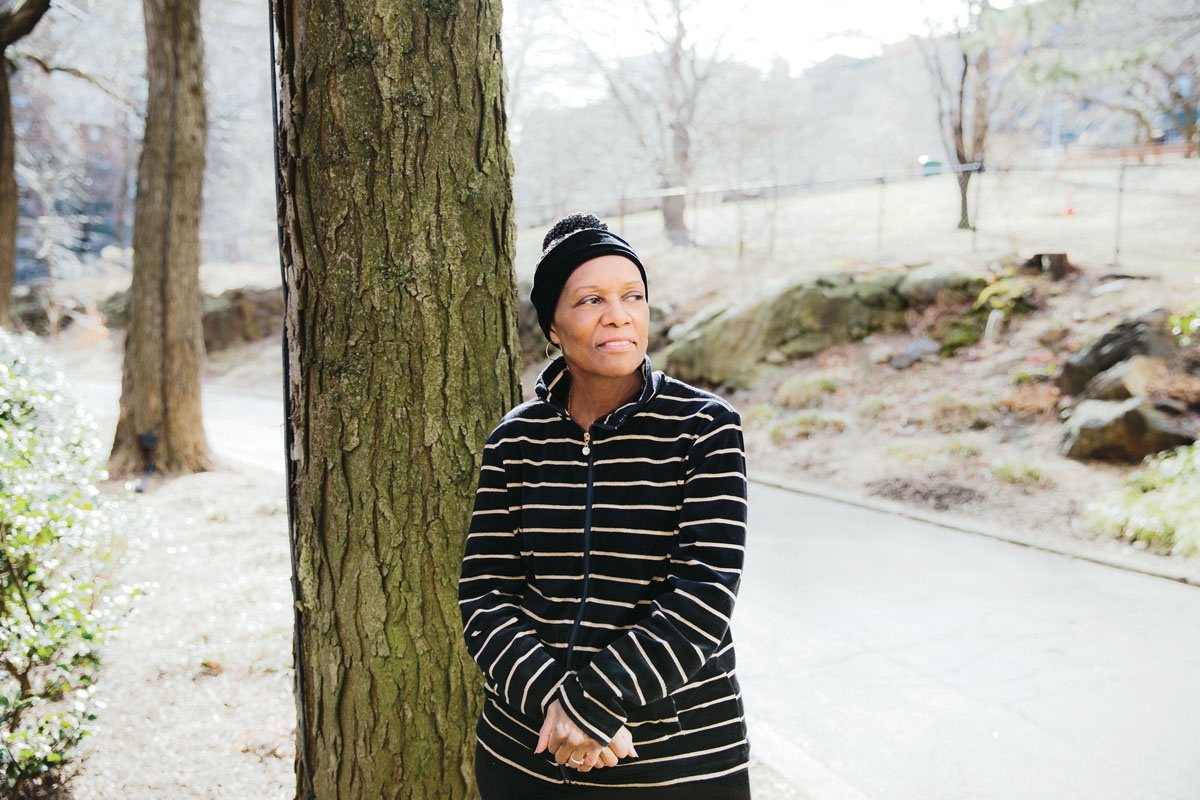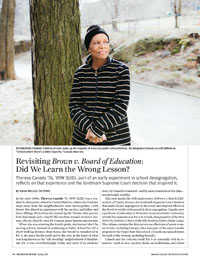Alumni Gazette
 INTEGRATING CHANGE: Children of color make up the majority of American public schoolchildren. Yet integrated schools are still defined as “schools where there’s a white majority,” Canada observes. (Photo: Shannon Taggart for Rochester Review)
INTEGRATING CHANGE: Children of color make up the majority of American public schoolchildren. Yet integrated schools are still defined as “schools where there’s a white majority,” Canada observes. (Photo: Shannon Taggart for Rochester Review)In the early 1960s, Theresa Canada ’76, ’89W (EdD) was a student in elementary school in Central Harlem, where she lived just steps away from the neighborhood’s main thoroughfare, 125th Street. She shared an apartment with her mother and father and three siblings, blocks from the storied Apollo Theater. Her parents both had steady jobs. Family life revolved around sit-down dinners, chores, church—and, for Canada, piano lessons and recitals.
When she was entering the fourth grade, she learned she’d be moving schools. Instead of continuing at Public School No. 157, a short walking distance from home, she would be transferred to P.S. 6, 40-some blocks south and to the east, in the heart of what was long known as the “silk stocking” neighborhood of Manhattan. P.S. 6 was overwhelmingly white, and most of its students were, by Canada’s standard—and by most standards at the time—astonishingly wealthy.
This year marks the 65th anniversary of Brown v. Board of Education of Topeka, Kansas, the landmark Supreme Court decision that ended de jure segregation in the South and inspired efforts in the North to rectify widespread de facto segregation. Canada, now a professor of education at Western Connecticut State University, revisits her experience at P.S. 6 in a book, Desegregation of the New York City Schools: A Story of the Silk Stocking Sisters (Peter Lang). The volume contains the first-person recollections of seven women of color, including Canada, who were part of the same transfer program to the Upper East Side school. (Canada uses pseudonyms for each of the women, including herself.)
Canada and her cohorts recall P.S. 6 as unusually rich in resources—such as new, modern desks, an auditorium, and a host of extracurricular opportunities—that weren’t available at their neighborhood schools. But for her part, Canada recalls her time at P.S. 6 as “a traumatic experience.” And while several of the women report mixed feelings, they remember teachers ill prepared to teach middle- and working-class black children, even though each of the women had been selected for the transfer program based on tests and teacher recommendations.
“Summer,” for example, recalls the teacher who sat students of color in “clusters”—always at the back of the room. Several of the women remember raising their hands but rarely being called upon—neither for answers to questions nor for the special classroom duties that schoolchildren often prize. And “Evelyn” has never forgotten the scolding that she alone received, in front of her classmates, for doing long division the “wrong” way, despite having arrived at correct answers.
Experiences like these have led Canada to count herself among critics of one of the most significant arguments in the Brown decision. “The argument [in Brown] was that segregated schools were psychologically damaging. But the key was, there was a distinct difference between what was provided in schools that were so-called segregated, as opposed to those that were basically white schools. It wasn’t about just sitting in class with white students.”
Her view is shared by a sizable number of so-called Brown “revisionists” within black communities. In 2004, the New York Times reported on a “shift in sides” on desegregation, pointing to disenchantment among many black parents with long bus rides and fraught politics—and a deep yearning for tight-knit neighborhood schools.
Canada, who still lives in the Harlem neighborhood of her youth, recalls its diversity when she started attending P.S. 6. There were her Greek neighbors who owned the beauty salon on the ground floor of her building and her friend across the street, whose parents were Chinese immigrants.
She recalls, as well, her first black teacher—a woman at P.S. 157 who “was strict as heck” but “made you feel that you could accomplish anything.”
But while there is sharp disagreement among stakeholders about how high to prioritize integration, Canada argues that demographics may dictate how the debate unfolds. According to the Pew Research Center, beginning in 2014, students of color went from a minority to making up a majority of American public schoolchildren.
“We define integrated schools as schools where there’s a white majority,” Canada says. If integration, as traditionally defined, continues to be a top priority, Canada worries that many schoolchildren will suffer from educational neglect.
“Schools that were once predominantly white are now mainly black and Latino,” Canada writes in the conclusion to her book. In that context, the major goal might not be integration. Instead, “[t]he key factor to consider is whether society has met the goal of educational equality.”
While she recalls P.S. 6 as “an excellent school, by any measure,” she echoes the mixed sentiments of Evelyn, who cried when she first learned that she would be transferring schools. There was “a feeling,” said Evelyn, “of, why couldn’t I have gotten that in my own neighborhood?”

